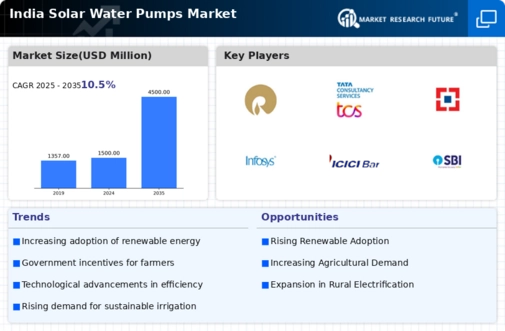Rising Energy Costs
The escalating costs of conventional energy sources are propelling the adoption of solar water-pumps in India. As energy prices continue to rise, farmers and businesses are increasingly seeking cost-effective alternatives. Solar water-pumps provide a sustainable solution, allowing users to harness solar energy for irrigation and other water needs. This shift is particularly relevant in rural areas, where electricity supply can be erratic and expensive. The solar water-pumps market is likely to benefit from this trend, as it offers a long-term reduction in operational costs. By 2025, the market is anticipated to grow by over 25%, driven by the need for affordable energy solutions in agriculture and other sectors.
Climate Change Adaptation
The solar water-pumps market is increasingly recognized as a crucial tool for climate change adaptation in India. With changing weather patterns and erratic rainfall, farmers face significant challenges in securing water for irrigation. Solar water-pumps provide a reliable and sustainable solution, enabling farmers to mitigate the impacts of climate variability. The market is likely to expand as more farmers adopt these systems to ensure consistent water supply, regardless of climatic conditions. By 2025, the solar water-pumps market could see a notable increase in adoption rates, as awareness of climate resilience strategies grows among agricultural communities.
Government Policy Support
The solar water-pumps market is bolstered by favorable government policies aimed at promoting renewable energy. Initiatives such as the Pradhan Mantri Kisan Urja Suraksha evam Utthaan Mahabhiyan (PM-KUSUM) scheme are designed to incentivize farmers to adopt solar technologies. This program aims to install 1.5 million solar water-pumps by 2025, significantly enhancing the market's growth potential. The government's commitment to increasing the share of renewable energy in the overall energy mix is likely to create a conducive environment for the solar water-pumps market. As policies evolve, the market could see increased investments and innovations, further driving adoption among farmers and rural communities.
Technological Innovations
The solar water-pumps market is witnessing rapid advancements in technology, enhancing the efficiency and reliability of solar-powered systems. Innovations such as smart irrigation solutions and improved battery storage capabilities are making solar water-pumps more attractive to users. These technologies not only optimize water usage but also reduce the overall cost of ownership. As the market evolves, manufacturers are likely to introduce more sophisticated products that cater to diverse agricultural needs. By 2025, the integration of IoT and AI in solar water-pumps could revolutionize water management practices, positioning the market for substantial growth as farmers seek to leverage these advancements.
Increasing Agricultural Demand
The solar water-pumps market is experiencing a surge in demand driven by the agricultural sector's need for efficient irrigation solutions. With approximately 60% of India's population engaged in agriculture, the reliance on traditional water sources is becoming increasingly unsustainable. Solar water-pumps offer a viable alternative, enabling farmers to access water without incurring high operational costs. The market is projected to grow as farmers seek to enhance productivity and reduce dependency on grid electricity. In 2025, the solar water-pumps market is expected to capture a significant share of the irrigation equipment market, which is valued at over $10 billion. This trend indicates a shift towards sustainable farming practices, positioning solar water-pumps as a critical component in modern agriculture.


















Leave a Comment